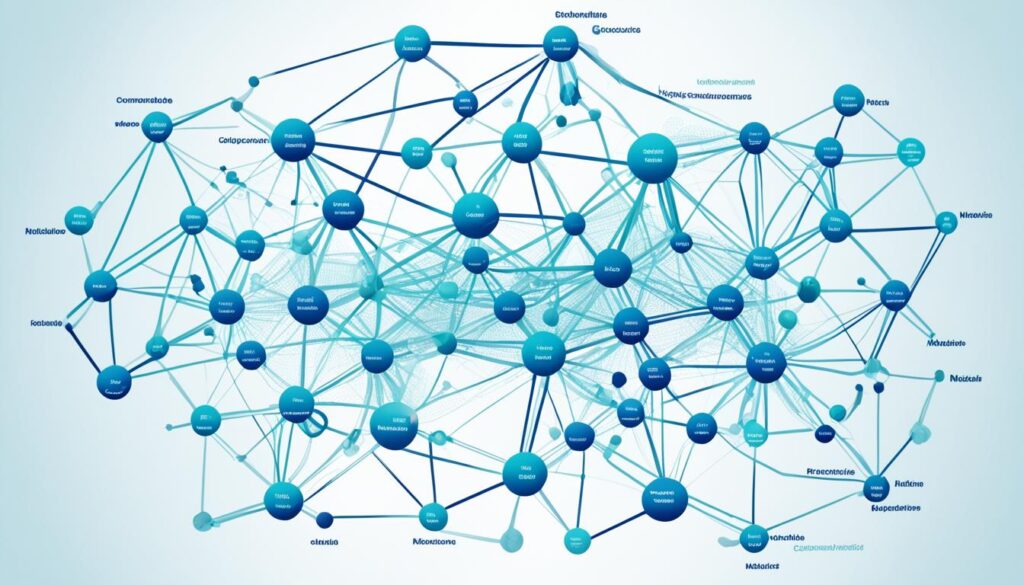Web 3.0 is poised to revolutionize the healthcare industry, ushering in a new era of transformation and innovation. With its emphasis on decentralized networks, advanced data management, and enhanced privacy and security measures, Web 3.0 offers unprecedented opportunities to address long-standing challenges and improve patient outcomes.
Key Takeaways:
- Web 3.0 utilizes decentralized networks, blockchain technology, and smart contracts to revolutionize healthcare.
- Interoperability and data sharing in the healthcare industry are significantly improved through Web 3.0.
- Personalized medicine thrives in the Web 3.0 era, allowing tailored treatment plans based on individual characteristics.
- Supply chain management in healthcare is enhanced with the use of blockchain technology.
- Web 3.0 accelerates research and innovation in healthcare, fostering collaboration and efficiency.
Interoperability and Data Sharing in Web 3.0 Healthcare
In the era of Web 3.0, interoperability and data sharing are critical factors in revolutionizing the healthcare industry. With the integration of decentralized technologies, particularly blockchain, healthcare providers can now overcome the challenges of seamless data exchange between different institutions and providers.
By leveraging blockchain’s secure, distributed, and tamper-proof storage capabilities, Web 3.0 enables the seamless exchange of patient information. This interoperability leads to enhanced patient care coordination, reduced medical errors, and improved research and public health insights.
“Web 3.0’s emphasis on interoperability and data sharing in healthcare enables healthcare providers to deliver more comprehensive and personalized care to patients.” – Dr. Katherine Wilson, Chief Medical Officer at MedTech Solutions
One key advantage of Web 3.0 interoperability is the ability to share patient data securely among different healthcare providers. This eliminates the need for manual data exchange processes, reduces administrative burdens, and ensures the accuracy and completeness of patient records.
Additionally, Web 3.0 enables the aggregation and analysis of anonymized patient data from diverse sources. This data-driven approach provides valuable insights for research and public health, contributing to the development of more effective treatment strategies, disease prevention programs, and personalized medicine.
Benefits of Interoperability and Data Sharing in Web 3.0 Healthcare
Interoperability and data sharing in Web 3.0 healthcare offer numerous benefits for providers, patients, and the healthcare industry as a whole:
- Enhanced patient care coordination and continuity across different healthcare settings
- Reduced medical errors through accurate and complete patient information
- Improved research outcomes and insights for evidence-based medicine
- Streamlined administrative processes and reduced costs
- Increased patient engagement and empowerment
- Better public health management and disease surveillance
Interoperability and Data Sharing Challenges in Web 3.0 Healthcare
While Web 3.0’s interoperability capabilities hold great promise, there are still challenges to overcome:
- Standardization: Establishing common standards and protocols for data exchange is crucial to ensure seamless interoperability.
- Privacy and Security: Protecting patient privacy and ensuring data security are essential considerations in the development and implementation of Web 3.0 healthcare solutions.
- Data Governance: Clear guidelines and regulations are necessary to govern the sharing, access, and use of patient data to maintain trust and confidentiality.
- Technical Infrastructure: Adequate infrastructure and resources need to be in place to support the secure and efficient exchange of healthcare data.
Despite these challenges, the healthcare industry is making significant strides towards achieving interoperability and data sharing in the Web 3.0 era. As technology advances and stakeholders collaborate, Web 3.0 holds the potential to transform healthcare by improving patient outcomes, research capabilities, and overall healthcare quality.

| Benefits of Interoperability and Data Sharing | Challenges of Interoperability and Data Sharing |
|---|---|
| 1. Enhanced patient care coordination and continuity | 1. Standardization |
| 2. Reduced medical errors | 2. Privacy and Security |
| 3. Improved research outcomes and insights | 3. Data Governance |
| 4. Streamlined administrative processes | 4. Technical Infrastructure |
| 5. Increased patient engagement and empowerment | |
| 6. Better public health management |
Personalized Medicine in the Web 3.0 Era
Web 3.0 technology is revolutionizing healthcare by empowering patients to take control of their health data and ushering in the era of personalized medicine. With Web 3.0’s advanced capabilities, healthcare providers can design tailored treatment plans that consider individual characteristics like genetic makeup, medical history, and lifestyle, ultimately improving accuracy and effectiveness in patient care.
Imagine a future where your healthcare provider can analyze your unique genetic predispositions and lifestyle factors to recommend specific actions that reduce the risk of future health issues. Web 3.0 enables this personalized approach to preventive care, bringing precision and proactive measures to safeguard your well-being.
“Web 3.0 technology empowers patients to actively participate in their treatment plans, tailoring healthcare to their specific needs and optimizing outcomes.”
The power of Web 3.0’s personalized medicine extends beyond just treatment plans. It unlocks the potential for targeted therapies, precise diagnostics, and patient-specific interventions that revolutionize the way we approach healthcare. By leveraging the wealth of data available through secure and decentralized networks, healthcare providers can collaborate with patients to create a deeper understanding of individual health profiles and develop more effective strategies.
Take control of your health and embrace the era of personalized medicine that Web 3.0 has ushered in. Together, we can unlock a future where healthcare is truly tailored to the unique needs and characteristics of each individual.

Benefits of Personalized Medicine in the Web 3.0 Era:
- Improved accuracy and effectiveness in treatment plans
- Proactive preventive care based on individual genetic predispositions and lifestyle factors
- Targeted therapies and precision diagnostics
- Enhanced collaboration between healthcare providers and patients
- Deeper understanding of individual health profiles
Enhancing Supply Chain Management with Web 3.0
The advent of Web 3.0 brings new opportunities to revolutionize supply chain management in the pharmaceutical and medical industries. By leveraging blockchain technology, Web 3.0 ensures the authentication of product origin, enables real-time tracking, and maintains tamper-proof records. This transformative technology mitigates the risk of counterfeit products and optimizes supply chain responsiveness, thereby enhancing patient safety and promoting the authenticity and transparency of medical products.
Implementing Web 3.0 in supply chain management offers numerous benefits. Let’s take a closer look at how this technology strengthens the pharmaceutical supply chain:
- Authentication of Origin: Blockchain technology provides a decentralized and immutable ledger that verifies the authenticity of pharmaceutical products. Each transaction recorded on the blockchain ensures traceability, verifying the origin of drugs and reducing the presence of counterfeit products in the supply chain.
- Real-Time Tracking: Web 3.0 enables real-time tracking of pharmaceutical products throughout the supply chain. By leveraging blockchain’s distributed ledger, stakeholders gain visibility into product movement, ensuring efficient logistics, and reducing delays and stockouts.
- Tamper-Proof Records: Using blockchain’s consensus mechanisms and cryptographic techniques, Web 3.0 ensures tamper-proof records of all supply chain activities. This transparency strengthens trust between stakeholders and safeguards against data manipulation or unauthorized changes.
- Enhanced Patient Safety: With the ability to track and verify the authenticity of pharmaceutical products, Web 3.0 greatly enhances patient safety. By minimizing the risk of counterfeit medications entering the market, patients can have confidence in the effectiveness and safety of their treatments.
- Transparency and Authenticity: Web 3.0’s blockchain technology promotes transparency and authenticity in the pharmaceutical supply chain. Stakeholders, including patients, healthcare providers, and regulatory bodies, gain access to accurate and reliable data, fostering trust and accountability within the ecosystem.
By embracing Web 3.0 and leveraging its blockchain-based supply chain management, the pharmaceutical industry can enhance patient safety, improve efficiency, and combat the growing threat of counterfeit medications. This technology holds the promise of transforming the industry, ensuring the authenticity and traceability of medical products.

Benefits of Web 3.0 in Pharmaceutical Supply Chain
| Benefits | Description |
|---|---|
| Authentication of Origin | Ensures the authenticity of pharmaceutical products by tracing their origin on the blockchain. |
| Real-Time Tracking | Enables real-time visibility of product movement, optimizing logistics and reducing delays and stockouts. |
| Tamper-Proof Records | Ensures the integrity of supply chain activities with immutable and auditable records on the blockchain, preventing data manipulation. |
| Enhanced Patient Safety | Reduces the risk of counterfeit medications, improving patient safety and confidence in treatment effectiveness. |
| Transparency and Authenticity | Promotes transparency and trust among stakeholders by providing accurate and reliable supply chain data. |
Advancing Research and Innovation in Web 3.0
Web 3.0, with its blockchain-powered smart contracts, is revolutionizing the field of medical research and driving innovation to new heights. By harnessing the power of decentralized networks and automation, Web 3.0 offers a multitude of benefits that streamline research processes, foster collaboration, and unlock breakthrough discoveries.

One of the key advantages of Web 3.0 in research lies in the automation of administrative tasks. By digitizing and automating processes such as document verification, clinical trial agreements, and data sharing, researchers can focus more on their work and less on paperwork. This increased efficiency enables faster project initiation, accelerates timelines, and ultimately leads to more prompt and impactful results.
Moreover, Web 3.0 facilitates seamless collaboration among researchers and institutions. By leveraging blockchain’s decentralized nature, research data can be securely shared across borders and organizations, eliminating silos and enabling multidisciplinary collaboration. This enhanced collaboration promotes knowledge exchange, fosters interdisciplinary research, and opens up possibilities for novel approaches and breakthroughs.
“Web 3.0’s decentralized networks and automation capabilities are transforming the way medical research is conducted. By fostering collaboration and streamlining processes, we can accelerate the discovery of new treatments, therapies, and solutions for pressing healthcare challenges.”
Web 3.0’s emphasis on transparency and trust is another critical aspect that fuels research and innovation. The inherent nature of blockchain technology ensures that research findings and data are tamper-proof and securely stored. This transparency boosts confidence among stakeholders, facilitating data sharing, peer review, and reproducibility of results. As a result, Web 3.0 promotes a culture of trust and collaboration, driving scientific progress further.
To illustrate the impact of Web 3.0 in research, let’s explore a case study:
A Case Study: Blockchain-Powered Clinical Trials
Blockchain technology has the potential to revolutionize the clinical trials process. By leveraging smart contracts, researchers can automate consent management, secure data sharing, and enforce protocol adherence. This automation reduces administrative burdens, ensures data integrity, and promotes participant privacy. With increased efficiency and transparency, blockchain-powered clinical trials hold immense promise in improving patient outcomes and accelerating the development of new treatments.
The table below showcases the key advantages of blockchain in medical research:
| Advantages of Blockchain in Medical Research | Explanation |
|---|---|
| Data Security | Immutable and tamper-proof storage of research data |
| Efficient Data Sharing | Secure and seamless sharing of research findings across institutions and borders |
| Protocol Automation | Automated enforcement of protocols, consent management, and adherence |
| Transparency and Trust | Enhanced trust among researchers, institutions, and participants through transparent processes and data integrity |
| Improved Patient Outcomes | Accelerated development of new treatments and therapies through streamlined research processes |
By leveraging the power of Web 3.0 and blockchain technology, the research landscape is poised for significant advancements. The automation of administrative tasks, streamlined collaboration, and emphasis on transparency and trust are revolutionizing medical research. The synergy between technology and innovation paves the way for breakthrough discoveries and, ultimately, improved healthcare outcomes for individuals worldwide.
Decentralized Networks in Web 3.0 Healthcare
In the era of Web 3.0, decentralized networks are reshaping the landscape of healthcare by prioritizing data integrity, privacy, and security. By leveraging technologies like blockchain, these networks distribute data across multiple nodes, reducing the risk of breaches and unauthorized access.
One of the key advantages of decentralized networks in healthcare is their ability to ensure secure data sharing. Encryption and cryptographic techniques are employed to safeguard sensitive patient information, enabling secure and controlled data exchange among authorized parties.
Patients also play a crucial role in decentralized healthcare networks. With Web 3.0, individuals have control over who can access their health data, empowering them to make informed decisions about sharing their personal information. This enhanced patient autonomy fosters trust and transparency in the healthcare system.
Moreover, decentralized networks offer enhanced reliability and resilience in healthcare data management. The distribution of data across multiple nodes ensures that even if one node fails or is compromised, the integrity of the overall system remains intact.
Incorporating Decentralized Networks in Healthcare
Integration of decentralized networks in healthcare holds immense potential for improving data security and facilitating seamless collaboration between healthcare providers, researchers, and patients. Through the adoption of Web 3.0 technologies, healthcare organizations can:
- Ensure secure and tamper-proof storage of patient records.
- Facilitate secure and controlled sharing of medical data.
- Enhance patient privacy and autonomy in data sharing.
- Improve data reliability and resilience in healthcare systems.
By embracing decentralized networks in Web 3.0, the healthcare industry can overcome data security challenges and transform the way patient information is managed and shared.
| Data Security Benefits of Decentralized Networks in Web 3.0 Healthcare | |
|---|---|
| Enhanced Data Privacy | Patients have control over their health data and decide who can access it, promoting privacy and confidentiality. |
| Data Integrity | Decentralized networks ensure secure storage and exchange of patient information, reducing the risk of data tampering. |
| Resilience to Breaches | The distribution of data across multiple nodes minimizes the impact of breaches, enhancing system resilience. |
| Improved Collaboration | Decentralized networks enable secure and controlled data sharing, fostering collaboration among healthcare stakeholders. |
Blockchain Technology in Healthcare
Blockchain, a foundational technology of Web 3.0, is revolutionizing the healthcare industry by ensuring secure and tamper-proof storage of patient records. With its robust encryption and decentralized nature, blockchain provides a trusted framework for protecting sensitive medical data from data breaches and unauthorized access.
One of the key advantages of blockchain in healthcare is its ability to facilitate secure sharing of medical data, improving interoperability between different healthcare providers and systems. Through blockchain, patient records can be securely and seamlessly exchanged, leading to enhanced care coordination and improved patient outcomes.
Additionally, blockchain technology streamlines billing and insurance processes through the use of smart contracts. These self-executing contracts automate transactions and eliminate the need for intermediaries, reducing administrative overhead and improving efficiency in healthcare financial operations.
Patients are also empowered with greater control and ownership of their health data through blockchain. They can grant access to their medical records to authorized parties, ensuring privacy and building trust in the system. This increased transparency and patient engagement contribute to the overall improvement of healthcare services.
“Blockchain has the potential to revolutionize healthcare by providing a secure and decentralized infrastructure for managing and sharing medical data.” – Dr. Sarah Johnson, Chief Medical Officer at MedTech Innovations
In summary, blockchain technology is a game-changer in the healthcare industry, offering secure storage, secure sharing, and improved privacy of medical data. Through its implementation, we can achieve enhanced interoperability, streamlined processes, and increased patient empowerment. Embracing blockchain in healthcare is a step towards a more efficient, secure, and patient-centric healthcare system.
Conclusion
Web 3.0 is poised to revolutionize the healthcare industry, ushering in a new era of transformative possibilities. Through its decentralized and inclusive nature, Web 3.0 offers solutions to long-standing challenges, paving the way for improved patient outcomes, transparency, and trust.
By leveraging Web 3.0 technologies, healthcare providers can achieve seamless data management, enhanced interoperability, and personalized medicine. Patients can take control of their health data, empowering them to actively participate in their healthcare journey. This shift towards patient empowerment not only improves individualized care but also contributes to preventive medicine, mitigating future health risks.
Furthermore, Web 3.0 enhances supply chain management in the healthcare industry, securing pharmaceutical and medical supply chains through the application of blockchain technology. This ensures the authenticity and transparency of medical products, safeguarding patient safety.
The future of healthcare lies in the realm of Web 3.0, where data security, privacy, and collaboration among stakeholders thrive. Embracing these technologies will shape the future of healthcare, improving data management, efficiency, and ultimately, the well-being of patients.
FAQ
How is Web 3.0 transforming the healthcare industry?
Web 3.0 is revolutionizing the healthcare industry by addressing challenges such as interoperability, data security, personalized medicine, supply chain management, and research and innovation. It leverages technologies like blockchain and smart contracts to enhance data management, privacy, and security.
What is the role of interoperability in Web 3.0 healthcare?
Web 3.0 enables seamless data exchange between different healthcare providers and institutions, enhancing patient care coordination, reducing medical errors, and improving research and public health insights.
How does Web 3.0 enable personalized medicine?
Web 3.0 empowers healthcare providers to design tailored treatment plans by considering individual characteristics such as genetic makeup, medical history, and lifestyle. This personalized approach improves the accuracy and effectiveness of healthcare.
How does Web 3.0 enhance supply chain management in healthcare?
Web 3.0 leverages blockchain technology to authenticate the origin of medical products, track them in real-time, and maintain tamper-proof records. This optimization of supply chain management reduces the risk of counterfeit products and enhances patient safety.
How does Web 3.0 advance research and innovation in healthcare?
Web 3.0 streamlines medical research by automating administrative tasks, clinical trial agreements, and data sharing processes through blockchain-powered smart contracts. This accelerates innovation, fosters collaboration among researchers, and enhances research outcomes.
What are the benefits of Web 3.0’s decentralized networks in healthcare?
Web 3.0’s decentralized networks prioritize data integrity, privacy, and security. They distribute data across multiple nodes, reducing the risk of breaches and unauthorized access. Encryption and cryptographic techniques ensure secure data sharing, enhancing reliability, resilience, and trust in healthcare data management.
How does blockchain technology contribute to healthcare?
Blockchain, a foundational technology of Web 3.0, ensures secure and tamper-proof storage of patient records, facilitates secure sharing of medical data, improves interoperability, and streamlines billing and insurance processes through smart contracts. This technology empowers patients, enhances privacy, and builds trust in the healthcare system.
What is the future of healthcare with Web 3.0?
Embracing Web 3.0 technologies will shape the future of healthcare by enhancing data security, privacy, and collaboration among stakeholders. It promotes transparency, trust, and improved patient outcomes, revolutionizing data management, interoperability, personalized medicine, supply chain management, research, and innovation.







